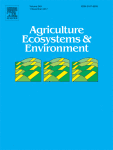Ver ítem
- xmlui.general.dspace_homeCentros Regionales y EEAsCentro Regional CórdobaEEA Marcos JuárezArtículos científicosxmlui.ArtifactBrowser.ItemViewer.trail
- Inicio
- Centros Regionales y EEAs
- Centro Regional Córdoba
- EEA Marcos Juárez
- Artículos científicos
- Ver ítem
Root colonizing and soil borne communities of arbuscular mycorrhizal fungi differ among soybean fields with contrasting historical land use
Resumen
Arbuscular mycorrhizal fungi (AMF) are a key component of soil microbiota in natural and anthropogenic ecosystems. Even though soil type and climate conditioned land uses in the past, soybean cultivation has overrode such limitations and replaced the earlier diverse agro- and natural ecosystems in many countries of South America. We investigated whether actual diversity patterns of local AMF communities were determined by previous land uses and their
[ver mas...]
Arbuscular mycorrhizal fungi (AMF) are a key component of soil microbiota in natural and anthropogenic ecosystems. Even though soil type and climate conditioned land uses in the past, soybean cultivation has overrode such limitations and replaced the earlier diverse agro- and natural ecosystems in many countries of South America. We investigated whether actual diversity patterns of local AMF communities were determined by previous land uses and their intrinsic environmental conditions. We sequenced AMF DNA from root and soil samples collected from current soybean fields with three historical land use situations (HLU): agricultural fields, livestock farming and forest sites. We detected overall high AMF richness: 87 virtual taxa (VT) in soil and 69 VT in soybean roots. Mean number of VT per sample ranged from 8.1 to 19.2; it was not affected by HLU nor type of sample, but correlated with soil texture, pH, and plant density. Conversely, AMF community composition did significantly diverge among HLU and type of sample. A distinctive community composition was observed in roots of historical agricultural fields which differed from any other soil and root sample evaluated in this study. We attribute this finding to variations in the abundance pattern of predominant AMF taxa (Glomeraceae and Gigasporaceae). Our results indicate that soybean cultivation supports relatively high AMF diversity, with apparent legacies from earlier management and natural habitats in the composition of resident AMF communities.
[Cerrar]

Autor
Faggioli, Valeria Soledad;
Cabello, Marta Noemí;
Grilli, Gabriel;
Vasar, Martti;
Covacevich, Fernanda;
Öpik, Maarja;
Fuente
Agriculture, Ecosystems & Environment 269 : 174-182 (January 2019)
Fecha
2019-01
Editorial
Elsevier
ISSN
0167-8809
Documentos Relacionados
Formato
pdf
Tipo de documento
artículo
Proyectos
(ver más)
INTA/PNCYO-1127033/AR./Manejo nutricional de cereales y oleaginosas para la intensificación sustentable de los sistemas productivos
INTA/PNSUELO-1134043/AR./Caracterización y funcionalidad de la biota del suelo.
INTA/REDAE-1136021/AR./RED DE AGROECOLOGIA
INTA/REDGEN-1137041/AR./PLAN DE GESTIÓN RED RECURSOS GENETICOS MICROBIANOS
Palabras Claves
Derechos de acceso
Restringido
 Excepto donde se diga explicitamente, este item se publica bajo la siguiente descripción: Creative Commons Attribution-NonCommercial-ShareAlike 2.5 Unported (CC BY-NC-SA 2.5)
Excepto donde se diga explicitamente, este item se publica bajo la siguiente descripción: Creative Commons Attribution-NonCommercial-ShareAlike 2.5 Unported (CC BY-NC-SA 2.5)

